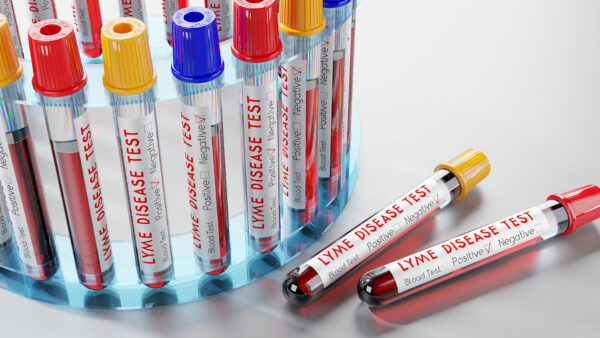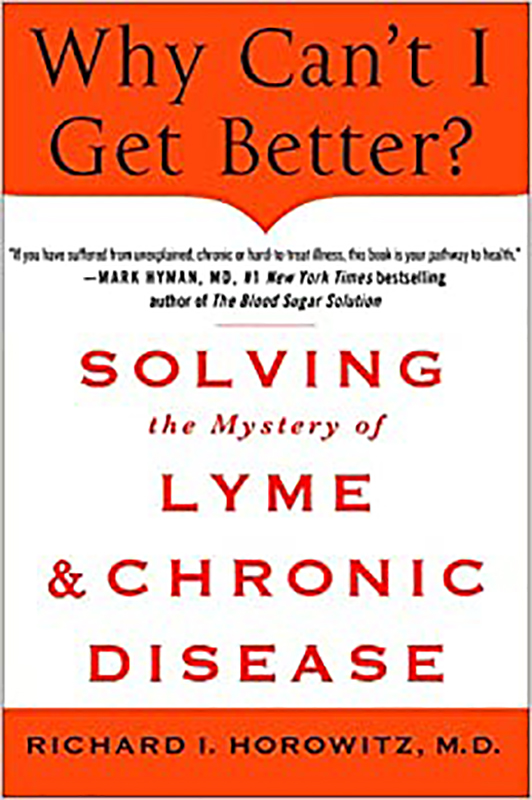Chronic Lyme Disease
Demystifying Lyme Disease
Understanding, Diagnosing, & Treating This Mysterious Illness

Dr. Aaron Hartman
October 12, 2023

Editor’s Note: The content in this article was originally a short series posted in March–April of this year. However, we’ve seen an increase in searches online for solutions to Lyme Disease, so we are consolidating the content into one article and republishing it here in hopes that it will serve you and those you love looking for answers.
It’s surprising that one of the top infectious diseases in our country – Chronic Lyme Disease – has more annual incidences recorded by the CDC than breast cancer.
It’s surprising that one of the top infectious diseases in our country – Chronic Lyme Disease – has more annual incidences recorded by the CDC than breast cancer. Lyme is also overlooked in medical school and education about infectious diseases. In this article, I would like to discuss the burden of Lyme disease in our country, how and why it’s so often misdiagnosed, how we get to a correct diagnosis, and how to go about treating Lyme.
The Burden of Lyme Disease in the US
The number of Lyme disease cases in the US is greater than that of breast cancer, which is a staggering statistic. The CDC map of Lyme disease implies that Lyme is isolated to the upper Northeast of the US. However, the map from the Lyme Disease Association (pulling CDC data) shows that almost every state in the country has reported cases of the disease.

There are different strains in Europe, and even an epidemic of Lyme disease right now in China.
Why the disparity between the CDC and the reports from the Lyme Disease Association?

Underdiagnosing & Misdiagnosing Lyme
The major problem with the way we currently test for Lyme disease is that it’s based on only one strain of the bacterium Borrelia burgdorferi B31, which has been cultured in a lab for almost 50 years now. There are 30–40 other strains that can cause Lyme. As a result, Lyme disease is significantly underdiagnosed. These other strains can cause different types of Lyme, some that affect the neurological system, the heart, and the gut. However, these are overlooked by the basic testing used for surveillance in the United States, which is one of the reasons why many specialists overlook chronic Lyme disease.
In addition, current testing for Lyme disease is not particularly effective. When people are diagnosed with chronic fatigue, fibromyalgia, joint aches and pains, rheumatoid issues, and neurological problems these issues are sometimes actually caused by chronic, low-grade, tick-borne infections. According to research from iGenex, one of the most advanced tick-borne illness specialty labs in the country, over 50% of people who are positive for Lyme disease also have another tick-borne infection, such as Bartonella, Babesia, Anaplasma, Ehrlichia, Rocky Mountain Spotted Fever, or a tick-borne relapsing fever, which is a subclass of Lyme. These are overlooked in a standard Lyme panel. So 50% of people who test positive have a secondary infection like this, which may be missed.
The most common testing done in our country is a serum testing based on antibody response. However, in people who have long-term Lyme, their immune system is often suppressed, and they stop making antibodies. As a result, the basic surveillance test recommended by the CDC, which is an antibody test, is often falsely negative. Half of people who are later found to have Lyme disease actually had a negative initial screening test.
Misunderstood Clues to Lyme
The Missing Connection Between Lyme Disease & Autoimmune Disease
Autoimmune issues, such as multiple sclerosis or rheumatoid arthritis, are often related to an underlying, low-grade infection. I personally had a patient who was misdiagnosed with multiple sclerosis, but actually had neuro Lyme. After treating his Lyme disease, his “multiple sclerosis” symptoms went away.
I often see patients with strange symptoms like heart blocks, gut issues, joint pain, or rheumatological conditions, who don’t know that the cause of their illness is a tick-borne infection.
The Lyme bacteria (or spirochete) likes low-oxygen tissues such as connective tissues, fascia, joints, and ligaments, which also makes it hard for antibiotics to reach. Some people only experience rheumatism with joint aches and pains. Lyme disease triggers an inflammatory response that can cause the immune system to attack healthy tissues and organs, leading to various autoimmune diseases such as rheumatoid arthritis, multiple sclerosis, and lupus.
Hypermobility can actually make this pain worse. Tick-borne infections can also cause issues with the immune system referred to as mast cell activation syndrome (MCAS), making it quite complicated to handle treatments.

For more information on Autoimmune Disease and the role of chronic infections like Lyme, read my article “Chronic Health Issues Are On the Rise”
Getting the Diagnosis Right
A Lyme diagnosis can take time, especially if an initial test was negative. Sometimes the diagnosis is made after someone has tried to treat another condition with antibiotics and found that their symptoms improved. As a medical doctor, I prefer lab testing to verify a diagnosis, but this is not always possible.
Some of the more advanced testing values to determine if someone’s immune system is dysregulated include:
- CH50, which looks at a person’s complement system to see if it’s over regulated
- C3a and C4a to determine if the immune system is being exposed to mold or to bacterial cell wall components
- CD 57 antigen test, which tests natural killer cells and indicates whether the person’s innate immune system is suppressed
- Immunoglobulin testing with an IgG and then the IgG subclasses, which help me to see if this part of their immune system is suppressed
- Other specialty Lyme tests along with further immune system testing
Treatment Options & Considerations
Antibiotics
Sometimes I start with a trial of antibiotics such as doxycycline or amoxicillin, but many patients need additional support. There are also some other antibiotic drugs that can be used to get specifically to the senescent, or non-active, part of the infection. These include Flagyl (metronidazole) or tinidazole.
Immune System Support
Often the main issue with chronic Lyme disease is not the lack of antibiotics or the strength of the antibiotics used. The immune system needs support. I often find confounding factors that suppress the patient’s immune system, such as mold illness, undiagnosed sleep apnea, untreated gut issues, nutrient deficiencies, or past trauma.
These factors, which require skill, patience, and time, need to be addressed to help the immune system function optimally.
Medicinal Herbs
Medicinal herbs can also be helpful in supporting healing from Lyme disease. Japanese knotweed, from which resveretrol is sourced, and cat’s claw can help modulate a person’s immune system. Some herbalist practitioners use herbs exclusively because of failed antibiotic trials and have had amazing results.
Biofilm Busting
Biofilms are an important consideration in treating Lyme disease. Bacteria that cause chronic Lyme disease often live in the mucosal lining of the gut, arteries, and tissues in the form of biofilms. These biofilms are hard to break down, especially if they are in the gut. Medical practitioners often use enzymes such as nattokinase or lumbrokinase to help break down biofilms.
Anti-inflammatory Support
Anti-inflammatory agents such as fish oil, pro-resolving mediators, and other potent anti-inflammatories can help support a person’s immune system to fight off the infection.
Advanced Therapies
The most challenging cases often require more advanced therapies such as IV vitamin C, ozone therapy, blood radiation, and/or hyperbaric medicine, which can help boost the immune system and force oxygen into tissues where Lyme disease lives.
Conclusion
Lyme disease is a serious issue in the United States, and it’s important to understand how prevalent it is, the challenges in diagnosing it, and the controversy surrounding it.
Our current standard testing for Lyme disease is inadequate. Proper testing and diagnosis are crucial in the treatment of Lyme disease, and it’s important for healthcare professionals and individuals to be informed about this disease to prevent long-term complications. Determining whether symptoms are coming from an underlying Lyme infection requires a skilled clinician who knows what symptoms to look for, knows what the associated illnesses are, and knows how to address them.
Chronic Lyme disease can be a complicated condition both to diagnose and treat. It requires a broad approach to address the underlying chronic illness, which can include immune system support, medicinal herbs, anti-biofilm support , anti-inflammatory support, and advanced therapies. Specialized testing is also essential to monitor the immune system and determine the appropriate course of treatment.
Further Reading
The Lyme Solution
A 5-Part Plan to Fight the Inflammatory Auto-Immune Response and Beat Lyme Disease
Darin Ingels ND
Lyme Disease is a great imitator and can be difficult to eradicate in certain individuals. This book reviews the myriad presentations of Lyme Disease and reviews the complex treatment options that can be implemented in those who do not respond to standard of care treatments.
Why Can’t I get Better?
Solving the Mystery of Lyme and Chronic Disease
Richard Horowitz MD
Dr. Horowitz is an internal medicine physician who moved his practice Hudson Valley, New York almost 30 years ago. He had no idea he was moving into the Lyme capital of the country. Over the years, treating many patients with Chronic Lyme Disease, Dr. Horowitz has developed a very specialized practice and way of evaluating and treating Lymes and MSIDS patients. He outlines his 16 point MSIDS map and treatment paradigm in this book. He follows the ILADS model. His book is a good overview of this treatment paradigm and he is a thought leader in this arena. He is not a functional medicine practitioner per sea and so doesn’t necessarily follow the functional medicine matrix systems based model. This book is great for anyone who currently has or is interested in Lyme’s, Multiple Systems Infectious Disease Syndrome or associated diseases.
The Autoimmune Solution
Prevent and Reverse the Full Spectrum of Inflammatory Symptoms and Diseases
Amy Myers MD
In her book, Dr. Myers describes her own battle with Grave’s Disease and her journey that resulted in the resolution of her own autoimmune illness. She outlines the Functional Medicine approach and summarizes the key steps she uses in her practice to address autoimmunity. The audiobook comes with a 146-page guide that includes recipes and reviews the basic concepts in the book. This guide is very useful. This book, as well as Dr. Bloom’s, are general works that address autoimmune diseases and are not all-inclusive. Autoimmunity is a very complex topic and difficult to distill into one concise book.




